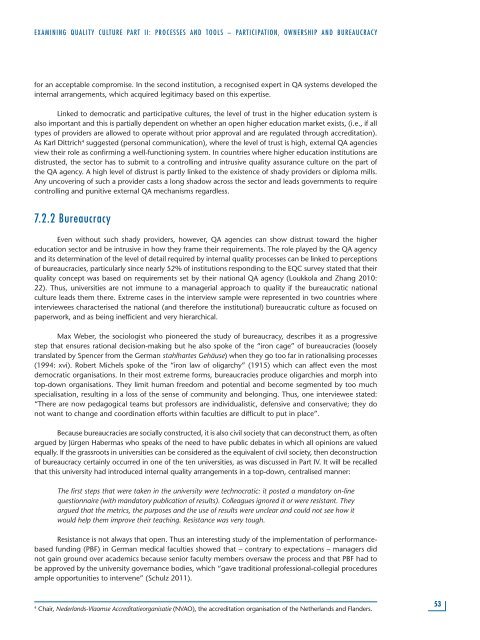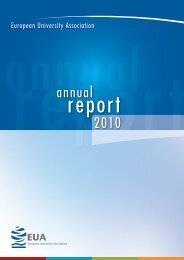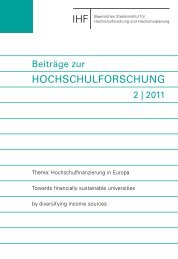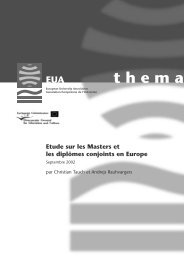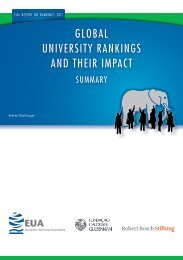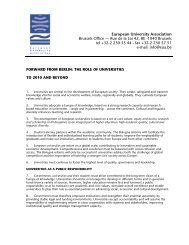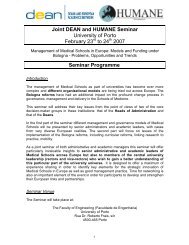Examining Quality Culture Part II: - European University Association
Examining Quality Culture Part II: - European University Association
Examining Quality Culture Part II: - European University Association
Create successful ePaper yourself
Turn your PDF publications into a flip-book with our unique Google optimized e-Paper software.
ExAmININg QUALITy CULTUrE PArT <strong>II</strong>: PrOCESSES ANd TOOLS – PArTICIPATION, OwNErShIP ANd BUrEAUCrACy<br />
for an acceptable compromise. In the second institution, a recognised expert in QA systems developed the<br />
internal arrangements, which acquired legitimacy based on this expertise.<br />
Linked to democratic and participative cultures, the level of trust in the higher education system is<br />
also important and this is partially dependent on whether an open higher education market exists, (i.e., if all<br />
types of providers are allowed to operate without prior approval and are regulated through accreditation).<br />
As Karl Dittrich 4 suggested (personal communication), where the level of trust is high, external QA agencies<br />
view their role as confirming a well-functioning system. In countries where higher education institutions are<br />
distrusted, the sector has to submit to a controlling and intrusive quality assurance culture on the part of<br />
the QA agency. A high level of distrust is partly linked to the existence of shady providers or diploma mills.<br />
Any uncovering of such a provider casts a long shadow across the sector and leads governments to require<br />
controlling and punitive external QA mechanisms regardless.<br />
7.2.2 Bureaucracy<br />
Even without such shady providers, however, QA agencies can show distrust toward the higher<br />
education sector and be intrusive in how they frame their requirements. The role played by the QA agency<br />
and its determination of the level of detail required by internal quality processes can be linked to perceptions<br />
of bureaucracies, particularly since nearly 52% of institutions responding to the EQC survey stated that their<br />
quality concept was based on requirements set by their national QA agency (Loukkola and Zhang 2010:<br />
22). Thus, universities are not immune to a managerial approach to quality if the bureaucratic national<br />
culture leads them there. Extreme cases in the interview sample were represented in two countries where<br />
interviewees characterised the national (and therefore the institutional) bureaucratic culture as focused on<br />
paperwork, and as being inefficient and very hierarchical.<br />
Max Weber, the sociologist who pioneered the study of bureaucracy, describes it as a progressive<br />
step that ensures rational decision-making but he also spoke of the “iron cage” of bureaucracies (loosely<br />
translated by Spencer from the German stahlhartes Gehäuse) when they go too far in rationalising processes<br />
(1994: xvi). Robert Michels spoke of the “iron law of oligarchy” (1915) which can affect even the most<br />
democratic organisations. In their most extreme forms, bureaucracies produce oligarchies and morph into<br />
top-down organisations. They limit human freedom and potential and become segmented by too much<br />
specialisation, resulting in a loss of the sense of community and belonging. Thus, one interviewee stated:<br />
“There are now pedagogical teams but professors are individualistic, defensive and conservative; they do<br />
not want to change and coordination efforts within faculties are difficult to put in place”.<br />
Because bureaucracies are socially constructed, it is also civil society that can deconstruct them, as often<br />
argued by Jürgen Habermas who speaks of the need to have public debates in which all opinions are valued<br />
equally. If the grassroots in universities can be considered as the equivalent of civil society, then deconstruction<br />
of bureaucracy certainly occurred in one of the ten universities, as was discussed in <strong>Part</strong> IV. It will be recalled<br />
that this university had introduced internal quality arrangements in a top-down, centralised manner:<br />
The first steps that were taken in the university were technocratic: it posted a mandatory on-line<br />
questionnaire (with mandatory publication of results). Colleagues ignored it or were resistant. They<br />
argued that the metrics, the purposes and the use of results were unclear and could not see how it<br />
would help them improve their teaching. Resistance was very tough.<br />
Resistance is not always that open. Thus an interesting study of the implementation of performancebased<br />
funding (PBF) in German medical faculties showed that – contrary to expectations – managers did<br />
not gain ground over academics because senior faculty members oversaw the process and that PBF had to<br />
be approved by the university governance bodies, which “gave traditional professional-collegial procedures<br />
ample opportunities to intervene” (Schulz 2011).<br />
4 Chair, Nederlands-Vlaamse Accreditatieorganisatie (NVAO), the accreditation organisation of the Netherlands and Flanders.<br />
53


